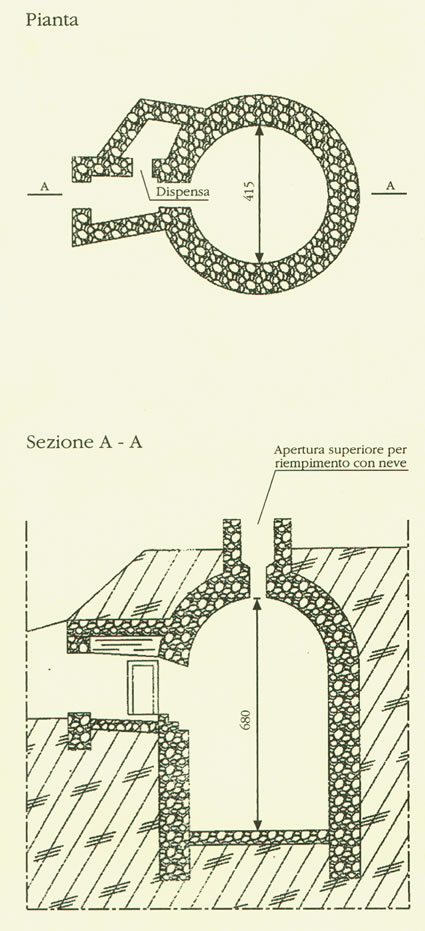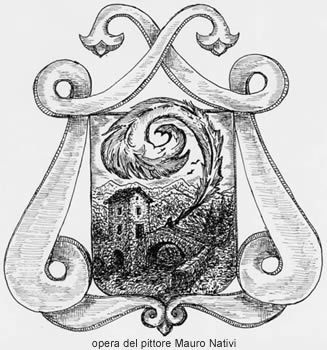"Gli Appennini sono per me un pezzo meraviglioso del creato. Alla grande pianura della regione padana segue una catena di monti che si eleva
dal basso per chiudere verso sud il continente tra due mari (....) è un così bizzarro groviglio di pareti montuose a ridosso l'una dall'altra;
spesso non si può nemmeno distinguere in che direzione scorre l'acqua."
J. W. Goethe, Viaggio in Italia (1786 - 1788)
J. W. Goethe, Viaggio in Italia (1786 - 1788)
The ice-safes for the use of the close Tuscany or more easily
as preserve (Conserve) in the low plane of Bologna played
a fundamental role in the poor local economy.
Their major function consisted in the conservation of different nourishments, for the most meat, bundled up sausages, cheese, butter and other dairy products.
The complex of the ice-safe of Piano del Voglio, built approximately around the end of the XV century, was in service of the adiacent palace La Torre (The Tower), commonly known as La Fattoria (The Farm). This denomination was attributed by the fact of being the residence of the farmer who managed the local possessions of the house of Ranuzzi de Bianchi.
Its structure is costituted enterely with hewn stones masterly walled up with dry technique following a linear planimetry of circular shape.
An access alley, of trapezoidal development, conducts in the inside or properly in the hall called Cella della Neve (Cellar of the Snow). The powerful constructive valence is exaltated by the inside dimensions: a diameter of more than 4 meters and an height of amost 7 meters.
Observing the superior hemispheric cupola it’ s possible to note the presence of a central hole.
From this cavity was introduced, from outside, the snow that, afterwards, was compressed inside this cellar to increase the duration and the refrigerating power.
Anyhow, the large complexive volume shouldn’t be related to the storing capacity. In fact, the alimenti to be consered were put in a modest lateral hollow called also for this reason the Dispensa (Store-room).
As it’s easily possible to observe the totality of the wall structure appears underground and covered by a thick and high vegetation.
This is not a casual situation, in fact, it was adopted to increase the conservative efficacy and in particular during the hot and sultry summer periods.
Moreover, in case of need was used an exceptional technique that consisted in putting over the superior cap an ordered layer of fascines to ameliorate the thermic isolation from the outside.
Inside the Piano territory, considering its extension during the period of the comital government, can be found many ice-safes, located in various geographical positions and some of these were assigned to the conservation of butter only, so for this called Burraie.
In these days, the ice-safe near the International Relax Camping, remains the only testimony on the territory of these pretty buildings.
So, hopefully it will be granted and valorized as a real monument to human talent in planning and constructing.
Author: MAURIZIO VALENTINI
Present in the issue intitled “La Ghiacciaia Comitale Ranuzzi de Banchi” created bythe Piano Documentation Center and patroned by the Group of Studies of the Valli Savena, Setta, Sambro.
Pictures
Their major function consisted in the conservation of different nourishments, for the most meat, bundled up sausages, cheese, butter and other dairy products.
The complex of the ice-safe of Piano del Voglio, built approximately around the end of the XV century, was in service of the adiacent palace La Torre (The Tower), commonly known as La Fattoria (The Farm). This denomination was attributed by the fact of being the residence of the farmer who managed the local possessions of the house of Ranuzzi de Bianchi.
Its structure is costituted enterely with hewn stones masterly walled up with dry technique following a linear planimetry of circular shape.
An access alley, of trapezoidal development, conducts in the inside or properly in the hall called Cella della Neve (Cellar of the Snow). The powerful constructive valence is exaltated by the inside dimensions: a diameter of more than 4 meters and an height of amost 7 meters.
Observing the superior hemispheric cupola it’ s possible to note the presence of a central hole.
From this cavity was introduced, from outside, the snow that, afterwards, was compressed inside this cellar to increase the duration and the refrigerating power.
Anyhow, the large complexive volume shouldn’t be related to the storing capacity. In fact, the alimenti to be consered were put in a modest lateral hollow called also for this reason the Dispensa (Store-room).
As it’s easily possible to observe the totality of the wall structure appears underground and covered by a thick and high vegetation.
This is not a casual situation, in fact, it was adopted to increase the conservative efficacy and in particular during the hot and sultry summer periods.
Moreover, in case of need was used an exceptional technique that consisted in putting over the superior cap an ordered layer of fascines to ameliorate the thermic isolation from the outside.
Inside the Piano territory, considering its extension during the period of the comital government, can be found many ice-safes, located in various geographical positions and some of these were assigned to the conservation of butter only, so for this called Burraie.
In these days, the ice-safe near the International Relax Camping, remains the only testimony on the territory of these pretty buildings.
So, hopefully it will be granted and valorized as a real monument to human talent in planning and constructing.
Author: MAURIZIO VALENTINI
Present in the issue intitled “La Ghiacciaia Comitale Ranuzzi de Banchi” created bythe Piano Documentation Center and patroned by the Group of Studies of the Valli Savena, Setta, Sambro.
Pictures
Thanks to the Design Studio Marco Sabbi for having supplied the drawing of this building. Also this drawing is included in the brochure about the Ranuzzi de Bianchi iced storage room. This brochure has been created by the Documentation Center of Pian del Voglio, supported by the Workgroup of the valleys Savena Setta Sambro and written by Maurizio Valentini.





